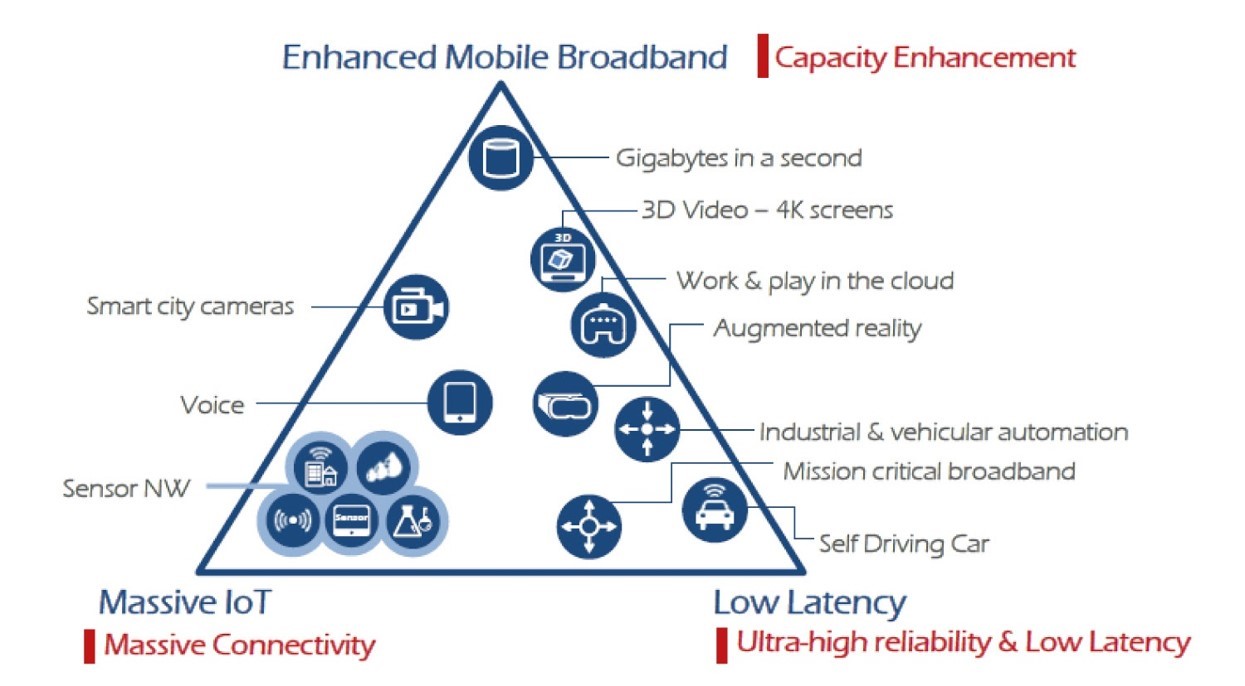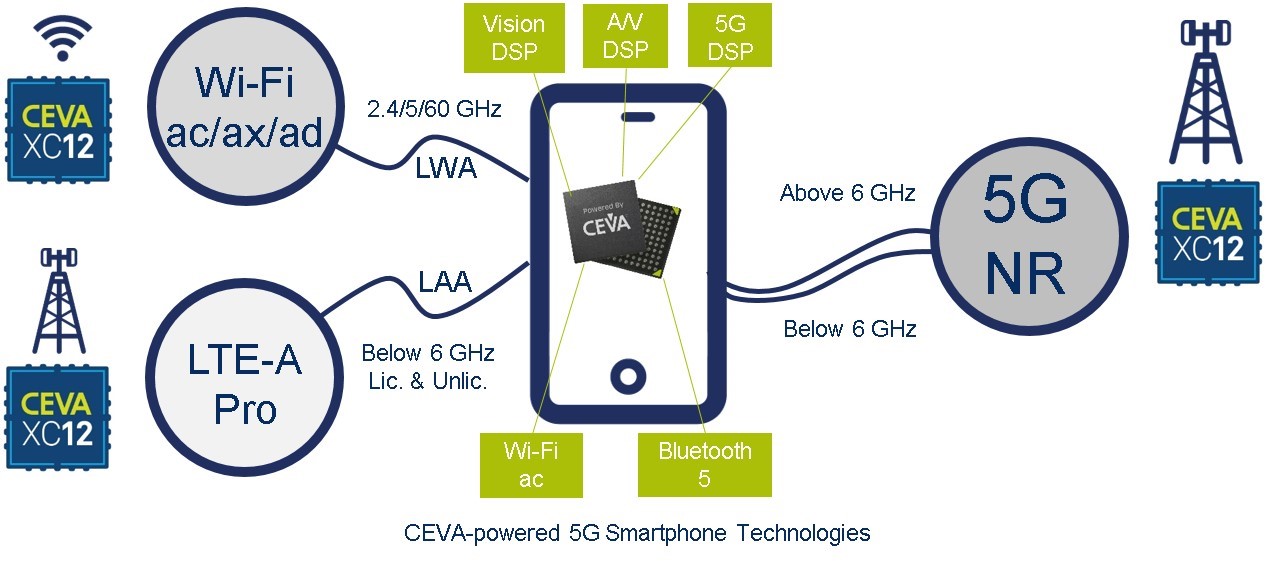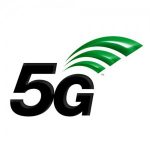MWC was rife with exciting demonstrations of new and evolving technologies. There were autonomous vehicles driving around on painted tracks, wireless virtual reality headsets (with long lines of people waiting to try them out), 4K video streaming, and even robots walking around the floor (the first I’ve seen, I don’t remember seeing any at CES). All that was fun and stimulating, but there was something truly remarkable about all those demos: the underlying technology that will soon make them all accessible everywhere and anywhere, not just in a convention hall. You guessed: I’m talking about 5G New Radio (NR).
 CEVA’s booth at MWC 2017
CEVA’s booth at MWC 2017
How 5G NR will Enhance Multiple Markets and Use Cases
What does 5G have to do with autonomous vehicles? AR/VR and 4K video? Robots? Smart cities? Each of these use cases has very different requirements, but they all need an efficient connectivity solution. The deployment of 5G will introduce a unified protocol that will bring together a massive number of users with requirements as diverse as MTC (Machine Type Communication) and eMBB (enhanced Mobile Broadband).
For MTC, which is characterized by low data rates and low duty cycles, the new protocol offers the capacity to handle a massive number of connected devices through LPWA (Low Power Wide Area) networks based on NB-IoT and Cat-M1 technologies. This makes it possible to significantly expand smart city infrastructure, like smart sensors and smart lights, which is expected to grow by a factor of ten in the next few years. In the diagram below, this category is in bottom left corner, termed Massive IoT.
On the other hand, eMBB requires very high data rates for intense streaming, like 4K Video, VR and other high data rate work and play use cases. For this category, shown at the top of the pyramid in the diagram below, 5G offers multi-gigabit connectivity.
Another important category of 5G users are the Low Latency use cases that require ultra-high reliability and cannot tolerate any unpredictable latency, shown in the bottom right corner below. The most prominent of these is ADAS and self-driving vehicles, which require Cellular V2X – vehicle-to-vehicle (V2V), vehicle-to-infrastructure (V2I) – connectivity. This category also includes mission critical scenarios in the security and healthcare domains. For these cases, the new protocol introduces much faster responsiveness with improved reliability and encryption.
 5G Diverse Uses Cases Mapped by Requirements
5G Diverse Uses Cases Mapped by Requirements
The 5G DSP Solution – CEVA-XC12
At MWC we proudly announced our solution to the daunting challenge of meeting all these diverse and complex demands: The CEVA-XC12 DSP core. Our most powerful communication DSP to date is designed specifically for multi-gigabit communication standards. It is tailored to meet the demands of 5G across the full spectrum of frequency bands from 400MHz to 80GHz and bandwidths from 20 to 800 MHz using 5G NR, V5GTF, LTE-A Pro, LAA, LWA, Wi-Fi 11ax, WiGig, C-V2X. This wide range of applications is made possible by the flexible architecture and multiple optional features. The result is a configurable, scalable solution that can serve any type of base-station, access points and terminals, ranging from Fixed Wireless Access Terminals, Enterprise WiFi 802.11ax Access Points and Small Cells all the way up to Macro-cell gNodeB (5G base-station) and Cloud RAN (radio access network).

The CEVA-XC12 is built for massive MIMO computation, with performance approaching 1 Tera operations per second (TOPs), when clocked at 1.8 GHz in 10 nm. Using a dedicated Instruction Set Architecture (ISA) for advanced multi-gigabit algorithms with 128 MAC per cycle and extended precision fixed and floating point arithmetic, the CEVA-XC12 can perform 256×256 dimension matrix processing, 1024 QAM Demodulation, 3-D Beamforming and more. The control plane incorporates a completely redesigned CPU/DSP scalar processing unit (SPU), with a whopping 4.4 CoreMark/MHz score, which runs, very efficiently, multi-tasking protocol, control and DSP code natively in C. This innovative SPU was designed to efficiently handle the huge number of users required for LTE MTC and 5G IoT and multi-RAT (radio access technologies) required by base-station to support legacy radios on top of 5G NR. In addition, it includes new core streaming interfaces that allow ultra-low latency transfers between cores or accelerators. All this comes with ultra-low power consumption, 50% less power than the previous generation CEVA-XC4500.
When Will the 5G Future Be Present?
 Currently, first 3GPP’s 5G NR ratification is planned for 2018, and 5G network deployments should begin in 2020. In the meanwhile, Verizon has been pushing forward their own next-generation network, backed by their own consortium, Verizon 5G Technology Forum (V5GTF) for Fixed Wireless Access (FWA). Together with Nokia, Verizon is already planning tests this year in 11 U.S. cities.
Currently, first 3GPP’s 5G NR ratification is planned for 2018, and 5G network deployments should begin in 2020. In the meanwhile, Verizon has been pushing forward their own next-generation network, backed by their own consortium, Verizon 5G Technology Forum (V5GTF) for Fixed Wireless Access (FWA). Together with Nokia, Verizon is already planning tests this year in 11 U.S. cities.
On the first day of MWC, in order to counter the V5GTF proposal, multiple operators including AT&T, NTT DOCOMO, SKT, KT, Vodafone, BT, Telstra, Sprint, Vivo, and Deutsche Telekom announced a partnership with equipment and chip manufacturers Ericsson, Huawei, ZTE, LGE, Qualcomm, and Intel to promote their own pre 5G NR. They presented the Non-standalone (NSA) 5G NR during March 6-9, 2017, 3GPP RAN meeting to be finalized by March 2018 with the objective of large-scale trials early 2019. We have already witnessed in previous cellular network generations, how 3GPP’s LTE crushed the competing WiMAX standard. That said, Verizon and Nokia are no small fish. This might cause 3GPP to accelerate the timetable for their 5G NR specification. It will be interesting to see how this plays out. In any case, this highlights how essential it is to have a flexible platform to support multiple pre 5G variants and flavors which will continue to evolve until 2020 when 5G NR is fully specified.
Learn more
Find out more about the CEVA-XC12.
Join our webinar to find out how 5G NR base-stations redefine the SDR paradigm.

